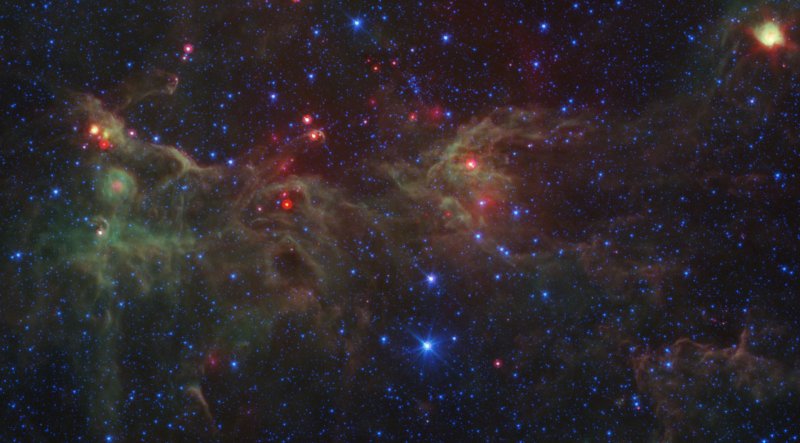
The above image of Sh 2-86 (NGC 6820, W55), the HII region ionised by the star cluster NGC 6823 in the Vul OB1 association, is from the astonishing Spitzer infrared mosaic of the inner galactic plane released by NASA this week. The mosaic, which consists of 16 enormous 24752x13520 pixel images along with a convenient 2400x3000 pixel guide poster and a zoomable Flash interface, is astonishing for two quite separate reasons.
First, the detail and scope of the images is unprecedented, and goes a long way towards stripping the veil of gas and dust from the inner galaxy. Many of the objects revealed are beautiful and mysterious, and show far greater complexity than lower resolution images at visual frequencies have been able to reveal to date.
Second, the mosaic is astonishing because it revolutionises the way astronomical data is presented and distributed. The trouble with many "virtual observatory" initiatives like Astrogrid and SkyView is that they mimic the way modern large telescopes operate. That is, they are difficult to use, display only small areas of the sky at once (often at a single frequency) and provide little or no context for the data. This is suitable for most (but not all) scientific purposes but is much less useful for non-professionals or to gain an understanding of how the Milky Way fits together as an overall structure.
The value of initiatives like Microsoft's WorldWide Telescope or Google Sky is the ability to pan or zoom over a huge area of sky at once - much more like a planetarium or simple binoculars than a complex telescope. The zoomable interface provided by the Spitzer team is a similar approach. Moreover, NASA's decision to release the entire Spitzer mosaic, which must be one of the largest single images ever created, makes it possible to provide other interfaces as well, including rendering it from within Google Sky or the WorldWide Telescope. This opens the way towards using features in that software to provide guided tours and overlays to give context to the Spitzer data - to go beyond the actual images to explaining their meaning and the roles that these objects play within the Milky Way.
In a recent review of the WorldWide Telescope, I complained that the data available with the beta version is decades old and does not include newer information available from Spitzer, IPHAS and the Canadian Galactic Plane radio survey. Now that the Spitzer team has released its mosaic, I hope that it will not take very long for it to be available through the WorldWide Telescope and Google Sky and that this will inspire other survey imaging teams to release their data in a similar way.
This garden universe vibrates complete.
Some we get a sound so sweet.
Vibrations reach on up to become light,
And then thru gamma, out of sight.
Between the eyes and ears there lie,
The sounds of colour and the light of a sigh.
And to hear the sun, what a thing to believe.
But it's all around if we could but perceive.
To know ultra-violet, infra-red and X-rays,
Beauty to find in so many ways.
Moody Blues, The Word
From In Search of the Lost Chord

